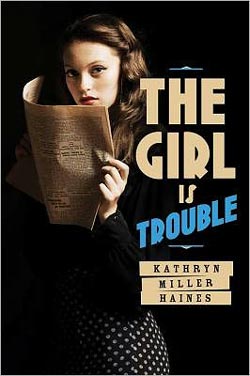
Iris Anderson and her father have finally come to an understanding. Iris is allowed to help out at her Pop’s detective agency as long as she follows his rules and learns from his technique. But when she uncovers details about her mother’s supposed suicide, suddenly Iris is thrown headfirst into her most intense and personal case yet.
I haven’t read a wide range of Young Adult mysteries, but The Girl is Trouble by Kathryn Miller Haines was, to me, just as complex morally as a mystery written for adults, with the added bonus that it was firmly set in a rich historical environment. Due to the dark content, I am pretty sure it is aimed at older teens. If I had to sum up the novel quickly, I’d call it “Veronica Mars in World War II.” The novel’s complex historical background is its strongest point, followed by its explorations of the heroine’s identity.
The heroine, Iris Anderson, is learning to be a private detective from her father, whose military career ended when he lost his lower leg at Pearl Harbor; subsequently, he lost his wife, and Iris lost her mother, to an apparent suicide. In addition to working on cases with him, Iris takes on an investigation at her school, where Jewish students are receiving threatening notes.
When the novel opens in New York City, the United States is in the midst of World War II. Haines gives a real flavor of not only what it felt like to be a high school student at that time, but sharply delineated pictures of several different neighborhoods, with their multifarious immigrant populations and their shifting range of social classes. Iris has to negotiate all sorts of conflicts based on ethnicity and class: her family used to have more money, her dead mother was German, and though she is Jewish, she and her father have lapsed in the practice of their religion.
We had heard stories about what was happening to Jews in Europe: pogroms, ghettos, yellow stars pinned to coats, and much, much worse things that, so far, hadn’t been verified. It was so much easier to hear about these awful things when you’d fooled yourself into believing they had nothing to do with you.
. . . “The principal’s office couldn’t care less. They think we’re a nuisance. They love us when we’re working on the school paper and editing the yearbook, but when we congregate and try to encourage dialogue about Jewish causes, they think we’re being too political.”
“I thought the Lower East Side was more open-minded than that.”
“Maybe more than where you come from, but no one wants us to flaunt it around here either.”
It was still an improvement. On the Upper East Side, you didn’t even talk about being Jewish.
“That’s why we need your help,” said Michael. “No one else is taking this seriously.”
Iris’s own heritage proves to be a major plot point as she unexpectedly gains new facts about her mother’s death, and decides to investigate for herself. She and a friend have to venture out of their familiar zones to obtain the facts of the case.
We continued on, eventually working our way onto East Eighty-sixth Street and weaving our way into the neighborhood called Yorkville. It was one of Manhattan’s many ethnic neighborhoods, only instead of being home to Eastern European immigrants and Italians like the Lower East Side, it was the Germans who had settled here. There was a time, Mama told me, when the streets were alive with German music and the scent of sauerbraten and other national delicacies wafted through the air. The German flag flew beside the Stars and Stripes, and the majority of the words that crammed the shopkeepers’ windows or were shouted from the newsstands were in the residents’ native tongue.
. . . “This place. Look at it. It’s like they’re trying to hide who they are.” He was right. The war had changed Yorkville. How couldn’t it? Anything German began to be viewed with suspicion; even the food underwent a sort of patriotic makeover by being assigned American names (no more sauerkraut— instead, enjoy liberty cabbage).
If you’re looking for multi-faceted history with your mystery, The Girl is Trouble is a novel for you.
Victoria Janssen is the author of three novels and numerous short stories. She has a World War I-set Spice Brief out in May titled “Under Her Uniform,” a tie-in to her novel The Moonlight Mistress. Follow her on Twitter: @victoriajanssen or find out more at victoriajanssen.com.
Read all posts by Victoria Janssen for Criminal Element.
See coverage of more new releases in our Fresh Meat series.
